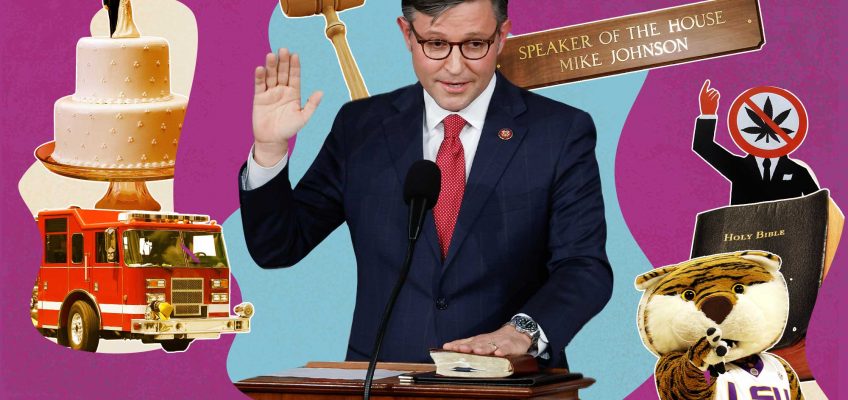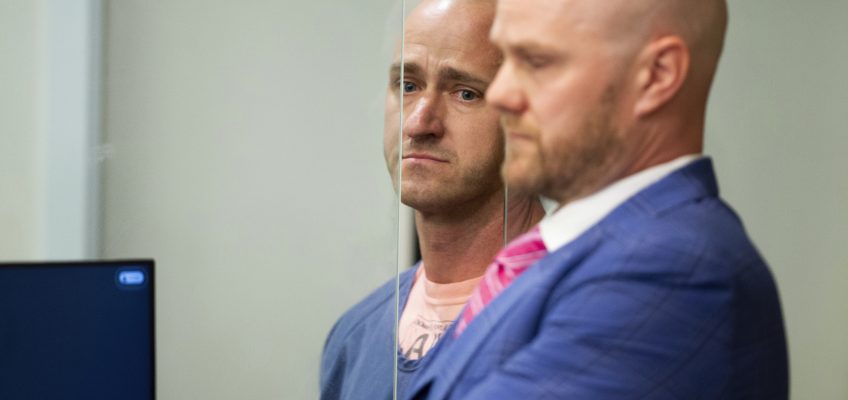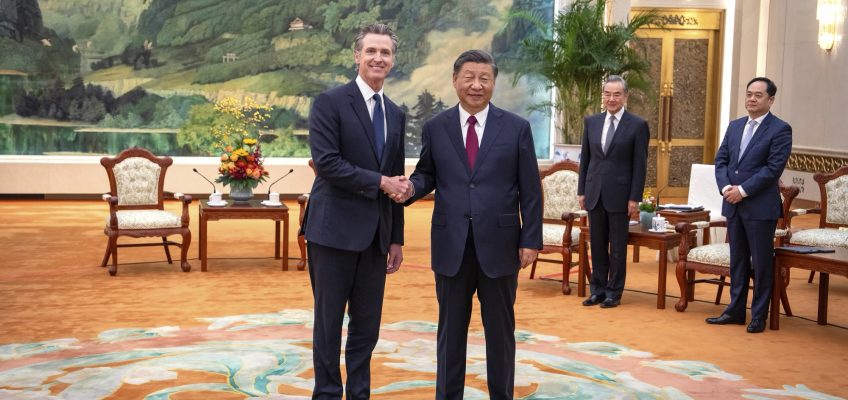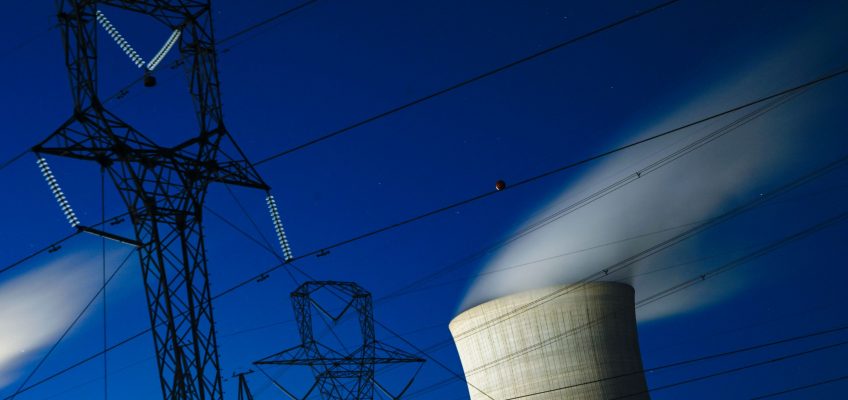Mike who?
Some three chaotic weeks after the shocking ouster of Kevin McCarthy, the new Republican speaker of the House is Mike Johnson, a hard-right legal warrior turned little-known legislator from Louisiana, a deeply religious, 51-year-old father of four who has been involved in electoral politics for less than nine years and in Washington for two years less than that.
A staunch social conservative with a long history of anti-LGBTQ rhetoric, he’s also managed on Capitol Hill to forge a less fractious persona, an ideological partisan and a Donald Trump ally who founded the so-called “Honor and Civility Caucus” pledging that “our political rivals in Congress are not our enemies.”
He now steps into the spotlight — and a seemingly impossible job in a fiercely divided Congress.
Government funding is scheduled to expire in less than a month, the GOP-controlled House will have to work with the Democratic-led Senate to not have a shutdown, and also on the docket are hard questions of aid for Ukraine and Israel. “You’re going to see an aggressive schedule in the days and weeks ahead,” Johnson said Wednesday. “You’re going to see Congress working as hard as it’s ever worked, and we are going to deliver for the American people.”
1.
All I ever aspired to be was a fireman,” Johnson once said.
2.
His father was a firefighter in Shreveport and suffered burns over 80 percent of his body in 1984 in an explosion that killed a fire captain. Johnson was 12. His parents, he has recalled, “wouldn’t let us be firemen after that.”
3.
“I saw an actual miracle of my father surviving when they said that he shouldn’t,” he has said. “It made me a person of very deep faith.”
4.
He was elected in 2015 unopposed in a special election to the Louisiana House of Representatives, serving parts of two incomplete terms.
5.
He was elected in 2016 in a runoff to represent Louisiana’s Fourth District in the United States House of Representatives.
6.
He is the least experienced speaker of the House in 140 years.
7.
He was the fourth nominee for the job after the ouster of Kevin McCarthy.
8.
He was born Jan. 30, 1972, in Shreveport, the oldest of four children — three boys and a girl.
9.
He earned an undergraduate business degree in 1995 from Louisiana State University, where he was public relations director of Kappa Sigma fraternity. He received his law degree in 1998 from LSU, too.
10.
He married the former Kelly Lary in 1999 in a “covenant marriage” — a kind of marriage that makes it harder to get a divorce.
11.
“My wife and I both come from traditional Christian households,” he once said. “My own parents are divorced. As anyone who goes through that knows, that was a traumatic thing for our whole family. I’m a big proponent of marriage and fidelity and all the things that go with it …”
12.
He and his wife appeared on ABC’s “Good Morning America” to support Louisiana’s newly passed Marriage Covenant Law.
13.
She is a former schoolteacher and a licensed pastoral counselor. They have four children — two daughters and two sons.
14.
They also have a podcast called “Truth be Told.”
15.
Before he ran for office, Johnson was a litigator for conservative causes, such as the Alliance Defending Freedom, for two decades.
16.
From 2004 to 2012, Johnson served as a trustee of the Southern Baptist Convention’s Ethics and Religious Liberty Commission.
17.
As a lawyer for the Alliance Defense Fund (the precursor of the Alliance Defending Freedom), Johnson wrote editorials for his local paper that called homosexuality “inherently unnatural.” “Your race, creed, and sex are what you are, while homosexuality and cross-dressing are things you do,” he wrote. “This is a free country, but we don’t give special protections for every person’s bizarre choices.”
18.
He is an ardent opponent of same-sex marriage. In the Louisiana House, he proposed the Marriage and Conscience Act, preventing adverse treatment by the state of anyone based on their views on marriage. The bill, in the view of critics, protects people who discriminate against same-sex couples.
19.
He defended Louisiana’s same-sex marriage ban before the Supreme Court in 2004 and again in 2014.
20.
Throughout his career, he has authored many bills aiming to restrict abortion access, including the Unborn Child Protection from Dismemberment Abortion Act, the Second Chance at Life Act (regarding reversing medical abortions) and the Protect the UNBORN Act.
21.
He led a “Life March” of some 7,000 people in Shreveport-Bossier City in 2015 and again in 2016.
22.
He opposes the legalization of marijuana, even medical marijuana, having called it a “gateway drug.”
23.
As a state legislator, he was known as “a social issues warrior,” according to the Advocate of Baton Rouge.
24.
“We’re the first country in the world who said our rights aren’t derived by a king but by our creator,” he said in co-authoring a bill that asked that the state’s elementary school students memorize and recite a portion of the Declaration of Independence. The bill received considerable support in the Louisiana House, but never made it past Senate committees.
25.
He was among a vast majority of lawmakers who voted to discourage the state’s law enforcement and government agencies from working with the Council on American-Islamic Relations, a Muslim civil rights organization. He said the effort wasn’t aimed against “people who believe in the Islamic faith” but simply was about opposing terrorism. “All of us here are opposed to terrorism,” he said, according to the Associated Press at the time. “That’s all this is about.”
26.
In 2016, he won his seat in the northwest corner of the state by more than 30 points against a pro-life, pro-gun Democrat.
27.
“As a matter of practicality and constitutional principle, the federal government should only be involved in disaster recovery when the scope of a disaster is so catastrophic that it overwhelms the capabilities of state and local governments,” Johnson said in 2016 when the Shreveport Times asked the candidates in that year’s campaign whether they would support lobbying the federal government for aid for disaster relief in the wake of recent flooding in the area. “Allowing a lower standard for federal funding is simply unsustainable, because it creates an incentive for state governments to seek aid for even small, routine events.”
28.
“In terms of financial assistance from the federal government, there’s no doubt that that will be necessary,” he said the following summer as Hurricane Harvey headed toward Louisiana.
29.
A climate-science skeptic, he’s raked in more campaign cash in his congressional career from the oil and gas industry than any other industry, and he’s repeatedly downplayed climate change, according to E&E.
30.
He considers himself a Constitutional “textualist” and treats his town halls in his district, he has said, partially as “Civics 101, Poli-Sci 101, Philosophy 101.”
31.
He was a new guy on the Hill and the opposite of a Trump favorite after he voted against Trump’s first attempt to overturn Obamacare in 2017. “I thought that might be the end of my career,” Johnson told the Shreveport Times. “The conversation was pretty intense.”
32.
In 2017, Johnson supported Trump’s “Muslim Ban” executive order, which restricted travel to the U.S. from seven predominantly Muslim countries. “This is not an effort to ban any religion, but rather an effort to adequately protect our homeland. We live in a dangerous world, and this important measure will help us balance freedom and security,” Johnson said of the order.
33.
In 2018, Johnson was one of a group of Republicans arguing for student-led prayer and religious expression in public schools under the First Amendment.
34.
After he was reelected in 2018, House Republicans elected him chair of the Republican Study Committee, a perch that made for a launching pad for the likes of Mike Pence and fellow Louisianan Steve Scalise.
35.
He is currently serving his second term as vice chai of the House Republican Conference, and serves on the House Judiciary Committee.
36.
Johnson, who sits on the House Armed Services Committee, supports ending American military aid to Ukraine during its war with Russia.
37.
He is rated as the 27th most effective Republican member of Congress by the Center for Effective Lawmaking at Vanderbilt.
38.
Johnson was part of Trump’s inner circle and traveled regularly with him on Air Force One while he was president. “It’s surreal,” he once told a Shreveport reporter. “When I call him, he calls back within a couple of hours.”
39.
He was an eager backer of the nomination to the Supreme Court of Amy Coney Barrett, a friend since 1988.
40.
“I have just called President Trump to say this: ‘stay strong and keep fighting, sir! The nation is depending upon your resolve. We must exhaust every available legal remedy to restore Americans’ trust in the fairness of our election system,’” he posted on social media four days after Election Day in 2020.
41.
He was a lead organizer of the December 2020 amicus brief in support of Texas v. Pennsylvania, the Supreme Court lawsuit contesting the election results.
42.
“I don’t see a grand conspiracy,” he said in the middle of that month. “What I see is a lot of chaos and confusion across the land, and the result is that this election will have this giant question mark hanging over it. I saw a new poll: a huge amount of the country doubts the election and thinks it was stolen from Donald Trump. Thirty-six percent of registered voters in America believe the election was stolen. That is a problem. Whether it was stolen or not, the fact that such a huge swath of the country believes that it was is something that should keep all of us up at night.”
43.
“And I am a lawyer. I don’t engage in conspiracy theory. I want to deal in fact and truth,” he added.
44.
Trump, he believes, is an institutionalist. “He doesn’t articulate it in the same way that some old constitutional-law nerds would,” he said, “but that’s what he is.”
45.
On Jan. 6, 2021, Johnson voted againstcertifying the 2020 election.
46.
As a member of the House Judiciary Committee, Johnson was one of Trump’s fiercest defenders in his impeachment hearings, leading Trump to include him in his defense team for the Senate impeachment trial, in which he was acquitted. About this, Johnson said, “His ultimate gesture of trust was asking me to serve on the impeachment defense team. It was an extraordinary experience.”
47.
Johnson, along with all other House Republican leaders in 2021, voted against establishing a national commission to investigate the Jan. 6 insurrection.
48.
Johnson had been floated as speaker before. In 2022, Rep. Andy Biggs proposed Johnson as speaker over Kevin McCarthy. After the House voted to remove McCarthy as speaker earlier this month, Florida Rep. Matt Gaetz showed his support for Johnson as a candidate.
49.
Running for Congress in 2016, he signed the congressional term limits pledge of the organization called U.S. Term Limits: “I pledge that as a member of Congress I will cosponsor and vote for the U.S. Term Limits amendment of three (3) House terms …”
50.
He’s in his fourth term.
51.
“Influence and access is everything in Washington,” he said in early 2020.
52.
“The reason I worked hard to be at the leadership table is because I want to help develop what that overall message is,” Johnson has said of his leadership style. “If you’re not at the leadership table you pretty much have to be a team player and go along with it.”
53.
He recently led a hearing on limiting gender-affirming care. “Sex isn’t something you are assigned at birth. It is a prenatal development that occurs when every unborn child is in its mother’s womb. You can’t surgically free yourself, or someone else, from this fact of life,” he said in his opening statement. “Today, nearly one in four high school students identifies as LGBTQ. Whether it’s by scalpel or by social coercion from teachers, professors, administrators and left-wing media, it’s an attempt to transition the young people of our country. Something has gone terribly wrong …”
54.
“I think he’s gonna be a fantastic speaker,” Trump said Wednesday at the courthouse in New York where he’s on trial for business fraud.




